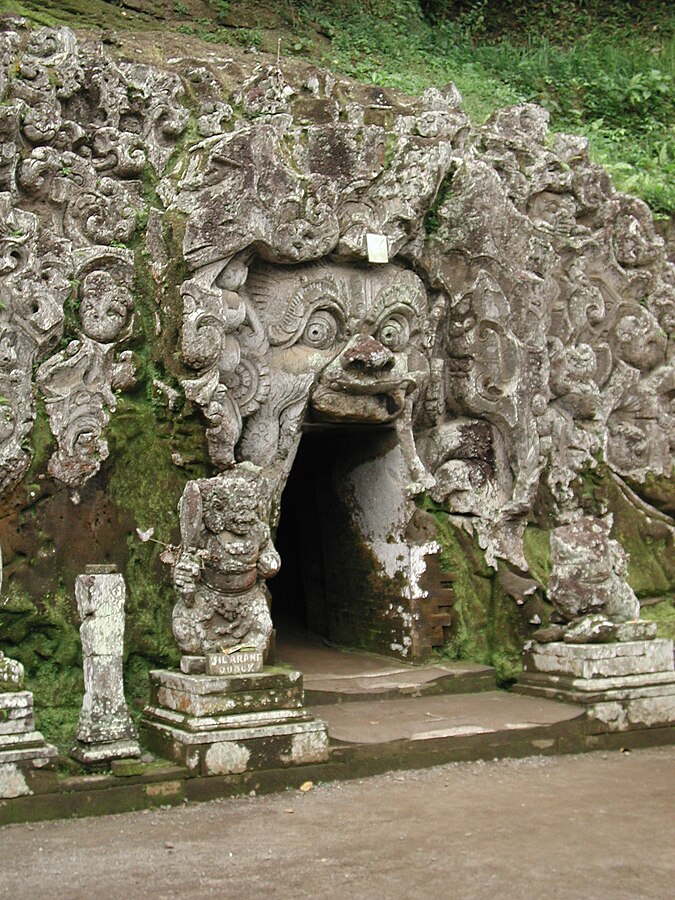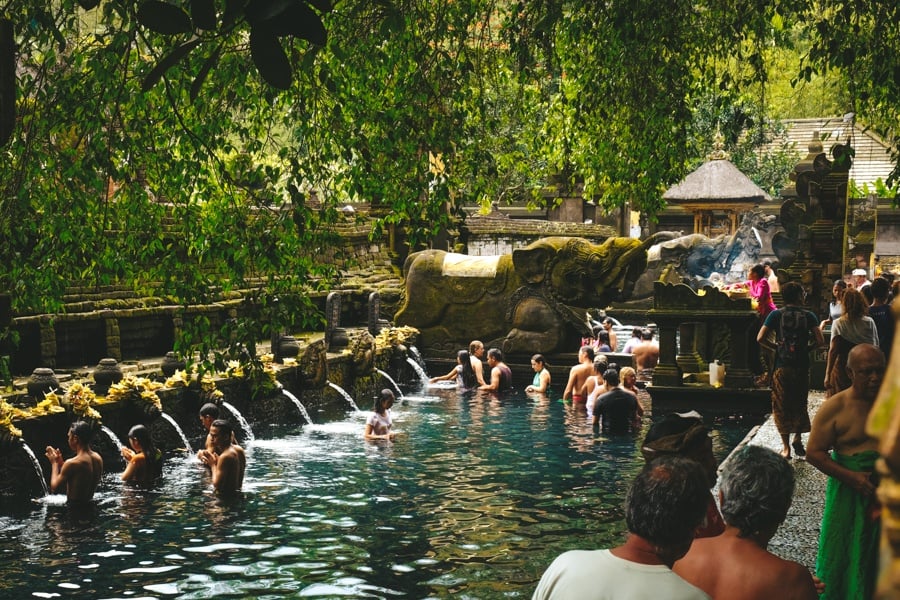
Goa Gajah

Goa Gajah meaning “The Elephant Cave”, is located on the island of Bali near Ubud. Built-in the 9th century, it served as a santuary.
Although the exact origins of the cave are uncertain, it is believed to have been built as a place for spiritual meditation. One folklore relates that it was created by the fingernail of the legendary giant Kebo Iwa. However, examining its style, the sanctuary was probably dated from the 11th century Bali Kingdom. The complex contains both Hindu and Buddhist imagery, as the cave contains lingam and yoni, symbols of Shiva, and the image of Ganesha, while by the river there are carved images of stupas and chattra, imagery of Buddhism.
The cave was rediscovered by Dutch archaeologists in 1923, but the fountains and bathing pool were not discovered until 1954.
The temple is characterized by menacing faces that are carved into the stone – whose purpose is assumed to be the warding off of evil spirits. The primary figure was once thought to be an elephant, hence the nickname Elephant Cave. Other sources state that it is named after the stone statue of the Hindu God Ganesh (characterized by having the head of an elephant) located inside of the temple. The site is mentioned in the Javanese poem Desawarnana written in 1365. An extensive bathing place on the site was not excavated until the 1950s. The entrance of the cave is accessed only by walking down a long flight of stairs. The inside of the temple is small and usually has trails of white smoke from the incense burning. Visitors wearing shorts will be issued a sarong to tie around the waist before entering the courtyard. The complex also contains 7 statues of women (out of which 1 has been destroyed due to an earthquake) holding water pitchers that depict seven holy rivers of India: the Gangga river, Sarasvati river, Godavari river, Sindhu river, Kaveri river, and Narmada river.
Tirta Empul

Tirta Empul Temple is a famous temple and religious spring in Bali where people go to do Hindu purification/bathing rituals.
Aside from having some great Instagram photo spots, it’s also been recognized as a UNESCO World Heritage Site with some unique cultural sights and history dating back to 960 AD.
Tirta Empul is just one of the many interesting attractions in the Ubud/Tegalalang area. This travel guide will explain how to get there, and everything you need to know before you go!
Tirta Empul Temple is an ancient temple complex built on top of a crystal clear natural spring.
A few areas are closed off to tourists, but for the most part you can wander everything freely and there’s a lot of neat details to look at.
The traditional Balinese doorways and statues make for great photo spots, along with a koi pond and huge banyan tree.
I would plan to spend up to 1 hour looking around the place, or longer if you want to bathe in the pool.

The Holy Spring
The main tourist attraction at Tirta Empul is the holy spring water where people (locals and foreigners alike) do purification bathing rituals according to Hindu customs.
There are two big pools with fountains of fresh water, and Balinese Hindus consider the springs to be holy, while a lot of spiritual tourists from around the world come here to bathe in them too.
You have to rent a special sarong for a small fee if you want to get in on the bathing ritual.
What To Wear To Temples In Bali
You’ll need to wear a sarong to enter most temples in Bali, including this one.
A sarong is a traditional skirt you tie around your waist, that can usually be rented on the spot.
In this case, the sarong is included for free in the ticket price for the temple.






